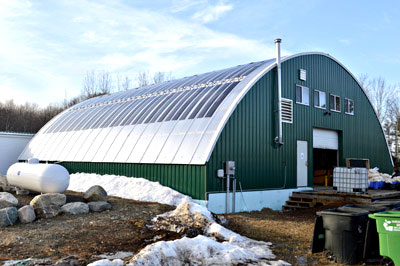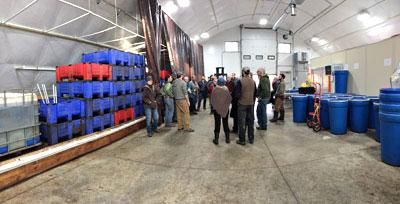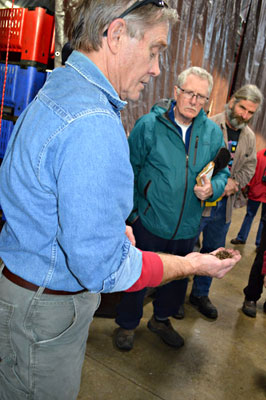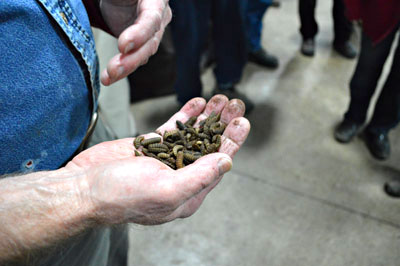 |
| This energy efficient Quonset-style building in Waldoboro currently houses black soldier fly larvae, which break down organic byproducts. |
 |
| Bins holding organic materials and maggots are on the left; bins on the right hold waste from food processors. |
 |
| Chris Heinig of Acadia Harvest says, “My goal is to see this operation take in waste and have absolutely nothing leave here as a waste. Everything that leaves here is actually a product.” |
 |
| Black soldier fly larvae |
By Jean English
Photos by the author
An early March 2018 tour of an energy-efficient farm structure in Waldoboro, Maine, generated interest not only in the building but in the fly farm that it housed.
Organized by the Knox-Lincoln Soil & Water Conservation District, Maine Coast Heritage Trust, Midcoast Farmers Alliance (as the first in their 2018 series of workshops and tours for farmers and gardeners) and the Maine Sustainable Agriculture Society (MESAS), the tour featured a 65- x 60-foot Quonset-style building that George Seaver, owner and operator of the Waldoboro Business Park, put up for his tenants, Acadia Harvest. Seaver is also vice president and general manager of Ocean Organics, which processes seaweed into soil amendments.
The Building
Bill Giordano, who works with the Sustainable Agriculture Year Round Cluster Initiative (SYRA) – a project of MESAS – and Seaver described the building, meant to demonstrate an affordable industrial space that can be solar powered to some degree, depending on the enterprise inside. Tony Kieffer of ArchSolar in Portland designed the structure, which is constructed with lightweight fiberglass I-beam arches made in China and a polycarbonate skin. The beams provide structural integrity and allow for an open-span arch without trussing. The building can be expanded by adding more arches. Project participants are interested in the possibility of having the beams made in Maine rather than China.
The south side of the building incorporates solar panels glued to the top of the roof, and a variation of a Trombe wall – a space between the exterior surface and interior plastic sheeting that acts as a passive collector. Air warms as it enters the bottom of the south side of the building and moves up to the roof and into a plenum. Based on the temperature inside the room, in the plenum and outside, warm air can be moved where needed.
The north side of the building is insulated with cellulose batting and includes a phase change material (a salt hydrate) that absorbs heat during the daytime as it changes from a solid to liquid. At a certain temperature, the material turns back to a solid, releasing heat in the process. “Energy savings via phase change materials is a key part of what we’re testing,” said Giordano. The phase change material is inside what looks like a large sheet of ketchup packets, he explained, and can release heat at a specified temperature. The material in the Waldoboro building is set to change at about 76 F.
The facility is heated and powered with photovoltaics and solar gain in the daytime, when excess energy is fed to the grid. At night a propane heater helps warm the building.
Sensors help control the heat and relay information to a sensor control unit, enabling remote monitoring and control of conditions in the structure, as well as collecting data about energy produced and used.
A building like the one in Waldoboro could be used to store food (including potatoes) or equipment, as a barn, for a controlled lighting situation or other agricultural purposes.
Giordano said that the Waldoboro building is one of SYRA’s two “poster children.” The other is a 45- x 144-foot greenhouse at MOFGA-certified organic Little River Flower Farm in Buxton, where plants grow in soil in raised beds. That project is taking a comprehensive look at higher tech options for warm-season crops year round. It includes a composite arched framing and standing seam-mounted polycarbonate paneling with a rooftop-mounted 1.4 kW photovoltaic array. Inside, phase change materials line raised beds to keep soil in the beds warmer longer. Two pellet-furnace-based heating systems provide direct-to-soil and ambient heat. A propane heater provides back-up. Modular LED lighting rigs are being tested for supplemental winter light.
The idea, said Giordano, is to explore whether it is cost-effective to grow tomatoes, cucumbers and cut flowers in a hot house year round using renewable heating and energy sources to supplement heating and lighting requirements. “This is where we feel direct-to-soil heat will shine,” he said.
Seaver estimated very roughly that the Waldoboro building cost about $300,000, not including the concrete work, drainage system and 1,000-gallon tank under the floor. “If you had just an arch building with a gravel floor and some cables to keep it from spreading, probably half that cost would go away,” he said. The phase change material alone cost $10,000. He didn’t want trusses because he wanted flexibility for future uses of his building. That required more concrete work for the foundation and hip walls to prevent spreading.
The Buxton facility is a prototype, so it is more expensive, but the goal is a similar facility for year-round veggies that would be built for about $250,000. Farmers generally want trussing in their greenhouses so that they can hang plants, irrigation materials, etc. “People who grow cannabis are looking for buildings like this,” added Seaver. He noted that these buildings are easier to clean than most because nothing in them can rust.
“Part of the goal,” said Giordano, “is to look at which technologies are the most viable and under which conditions. What is the payback period?”
Nanne Kennedy, vice president of MESAS, said the project is working on a calculator into which growers could plug data for their own markets, crops, location, etc., and get an economic analysis of the cost of the structure. MESAS often takes on projects that help create viable models for Maine farmers to scale up their operations, capture more of the consumer’s dollar and spend less on overall infrastructure.
The Fly Farm
Acadia Harvest received a grant from the National Science Foundation to make ingredients for fish feed from existing fish waste instead of from other ocean-caught fish. Acadia Harvest president Chris Heinig, a marine biologist, said the company seeds the fish waste with black soldier fly larvae (maggots). The flies reproduce, and the maggots multiply and consume the waste. When the larvae pupate, they climb to find a place to become a fly, conveniently falling into a tray where they are collected. “They’re referred to as ‘self-harvesting,’” said Seaver. The harvested maggots are dried to become a protein source for fish feed. Frass excreted by the maggots has agricultural properties.
Acadia Harvest, said Heinig, is involved in land-based aquaculture and has been growing California yellowtail, a high-end fish used in sushi. The company is also involved in producing an alternative aquaculture feed by replacing the protein source – currently ground foraged fish and fish meal, taken from anchovies and herring – with the dried fly larvae. “So this is a black soldier fly farm,” said Heinig.
The fly larvae are about 45 percent protein and 32 percent oil, while fish meal is about 60 percent protein. Josh Sturtevant of Acadia Harvest said that fish meal is a defatted product, and that if Acadia decides to press the oil out of the dried larvae, the protein level of its product would increase.
Heinig added that they might be able to top coat soy with some of the larvae. Because soy is a vegetable protein, fish are sometimes reluctant to eat it. Coating it with the larval product may make it more palatable to freshwater fish.
“We take in other people’s waste,” he added – including material from Garbage to Gardens and okara (a byproduct of tofu production) from Heiwa Tofu in Rockport, Maine. They’re also looking into brewery waste – “things that would normally be thrown out. My goal is to see this operation take in waste and have absolutely nothing leave here as a waste. Everything that leaves here is actually a product.”
The Synergies
Giordano said the clean technology and renewable energy sector are looking to collaborate with Maine farmers. “I find that every Maine farmer has their own way of reinventing the energy efficiency and heating efficiency wheel. SYRA is working to compile that wisdom, while testing new technologies that will help farmers decide what works best for their needs, with the long-term goal of a year-round labor force and maintaining year-round markets for local farmers across the state. If we all do a good job and work together, we can reduce our carbon fuel dependency and grow our farm businesses at the same time. There are many ways to do this, and they all take cooperation and willingness to share knowledge across industries.”
